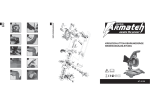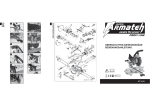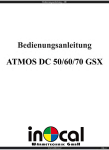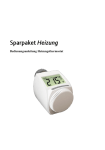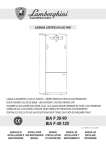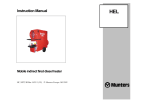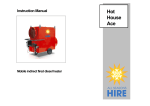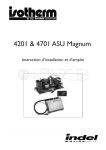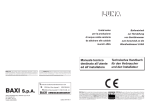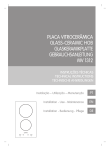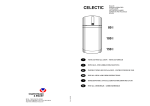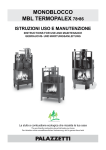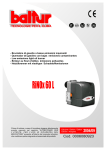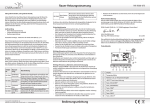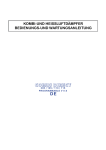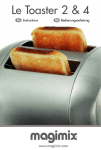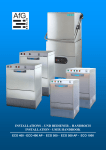Download DUO 30-90 - DUO 40-120
Transcript
1 AZIENDA CERTIFICATA ISO 9001 GRUPPI TERMICI IN GHISA AD ALTO RENDIMENTO HIGH EFFICIENCY CAST IRON BOILERS GROUPES THERMIQUES EN FONTE A RENDEMENT ELEVE HOCHLEISTUNGS-WÄRMEAGGREGATE AUS GUSSEISEN GRUPOS TÉRMICOS DE HIERRO FUNDIDO DE ALTO RENDIMIENTO DUO 30-90 - DUO 40-120 MANUAL PARA LA INSTALLATIONSMANUEL INSTALLATION MANUALE DI INSTALACIÓN Y UND INSTALLAZIONE E AND MAINTENANCE D'INSTALLATION ET D'ENTRETIEN WARTUNGSHANDBUCH EL MANTENIMIENTO MANUAL MANUTENZIONE 2 ITALIANO 4 3 Leggere attentamente le istruzioni ed avvertenze contenute sul presente libretto in quanto forniscono importanti indicazioni riguardanti la sicurezza d’installazione, d’uso e di manutenzione. Conservare con cura questo libretto per ogni ulteriore consultazione. L’installazione deve essere effetuata da personale qualificato che sarà responsabile del rispetto delle norme di sicurezza vigenti. 16 ENGLISH Read carefully all warnings and instructions contained in this manual as they give important safety instructions regarding installation, use and maintenance. Keep this manual for future reference. Installation must be carried out by qualified personnel who will be responsible for respecting existing safety regulations. FRANCAIS 28 Lire attentivement le mode d’emploi et les instructions du présent livret car ils fournissent des indications de l’emploi et de la manutention. Conserver avec soin ce livret pour ultérieures consultations. L’installation doit être effectuèe par un personnel qualifié qui sera responsable de respecter les normes de sécurité en viguer. DEUTSCH 40 Bitte lesen Sie die Anleitungen und Hinweise in dem vorliegenden Handbuch aufmerksam durch. Sie enthalten wichtige Informationen bezüglich Installation, Gebrauch und Wartung. Bewahren Sie dieses Handbuch zum späteren Nachschlagen sorgfältig auf. Die Installation ist von qualifiziertem Fachpersonal unter Berücksichtigung der geltenden Sicherheitsvorschriften durchzuführen. ESPANOL 52 Leer atentamente las instrucciones y las advertencias que contiene el presente folleto ya que dan indicaciones importantes relativas a la seguridad de la instalación, al uso y al mantenimiento. Conservar con cuidado este folleto para cualquier ulterior consulta. La instalación debe ser efectuada por personal cualificado que tendrá la responsabilidad de respetar las normas de seguridad vigentes. 4 INDICE PAGINA GENERALITÀ 5 DIMENSIONI mm. 5 CARATTERISTICHE TECNICHE 6 COMPONENTI PRINCIPALI 7 INSTALLAZIONE 8 COLLEGAMENTI ELETTRICI 9 CONTROLLI E VERIFICHE 12 ACCENSIONE - SPEGNIMENTO 12 CIRCUITO IDRAULICO 13 REGOLAZIONE BRUCIATORE 13 MANUTENZIONE 14 ISTALLAZIONE KIT OROLOGIO PROGRAMMATORE 15 REGOLAZIONE OROLOGIO PROGRAMMATORE 15 Complimenti... ... per l’ottima scelta ! La LAMBORGHINI garantisce non solo la qualità del prodotto, ma anche l’efficienza della sua rete di assistenza tecnica. Leggere attentamente le istruzioni ed avvertenze contenute sul presente libretto in quanto forniscono importanti indicazioni riguardanti la sicurezza d’installazione, d’uso e di manutenzione. Conservare con cura questo libretto per ogni ulteriore consultazione. L’installazione deve essere effettuata da personale qualificato che sarà responsabile del rispetto delle norme di sicurezza vigenti. 5 GENERALITÀ La caldaia DUO è un generatore di calore ad alto rendimento per il riscaldamento domestico e la produzione di acqua calda sanitaria, adatta a funzionare con bruciatori di gas o di gasolio. Il corpo caldaia e in ghisa, assemblati con tiranti e biconi. Il profilo è stato curato con una ripartizione delle alette consentendo un alta prestazione termica con conseguente risparmio energetico. L’estetica ed il completo isolamento sono assicurati da un elegante cruscotto, da un mantello verniciato ed assemblato a pressione, da un rivestimento in lana di vetro di grosso spessore che riduce al minimo le dispersioni di calore verso l’ambiente. DIMENSIONI mm. DUO 30-90 fig.1 DUO 40-120 a1 a2 a3 a4 Mandata riscaldamento Ø 1” Ritorno riscaldamento Ø 1” Uscita acqua calda Ø 3/4” Entrata acqua fredda Ø 3/4” a5 a6 a7 a8 Ricircolo Ø 3/4” Attacco valvola di sicurezza bollitore (eventuale) Ø 1/2” Uscita acqua calda Ø 1” Entrata acqua fredda Ø 1” 6 CARATTERISTICHE TECNICHE DUO Potenza termica utile Potenza termica focolare Rendimento utile P circuito acqua T 10OC Produzione acqua calda sanitaria T 30OC Prelievo di punta nei primi 10 minuti Ripristino Elementi Contenuto caldaia Contenuto bollitore Pressione di esercizio circuito di riscaldamento Pressione di esercizio circuito sanitario Mandata riscaldamento Ritorno riscaldamento Mandata bollitore Ritorno bollitore Ricircolo Vaso di espansione Peso Imballo kW kcal/h kW kcal/h % mbar l/h l min no l l bar bar Ø Ø Ø Ø Ø l kg mm. 30-90 40-120 30,6 26.316 34 29.240 90 1,8 800 130 9,5 3 14 90 3 6 1” 1” 3/4” 3/4” 3/4” 10 180 600x900x1560 46,5 39.990 51,4 44.204 90,4 4,2 1.200 145 8,5 4 17 120 3 6 1” 1” 1” 1” 3/4” 10 285 660x1085x1560 CARATTERISTICHE CIRCOLATORE Portata/prevalenza disponibile all’impianto fig.2 7 COMPONENTI PRINCIPALI DUO 30-90 fig.3 DUO 40-120 fig.4 1 2 3 4 5 6 7 Valvola di sicurezza Termostato riarmo manuale Circolatore sanitario Bruciatore Circolatore riscaldamento Valvola automatica sfogo aria Attacco per idrometro 8 Pozzetto sonde: termometro termostato di regolazione termostato di minima 9 Vaso espansione 10 Pozzetto sonde: termostato bollitore 11 12 13 14 15 termometro bollitore Bollitore Anodo di magnesio Corpo caldaia Valvola di non ritorno Attacco eventuale per valvola sicurezza bollitore 8 CRUSCOTTO DUO 30-90 fig.5 CRUSCOTTO DUO 40-120 fig.6 INSTALLAZIONE L’installazione della caldaia deve essere effettuata solo da Personale Qualificato, seguendo le indicazioni del Costruttore ed in ottemperanza a tutte le leggi e disposizioni che regalano la materia. Si raccomanda in particolar modo il rispetto delle norme in materia di sicurezza e di quelle che regolano la costruzione e l’ubicazionedelle canne fumarie. ALLACCIAMENTO IDRAULICO Eseguire l’allacciamento idraulico dell’apparecchio rispettando le indicazioni poste in prossimità di ogni attacco e quelle riportate nella figura 1 di questo libretto. L’allacciamento deve essere fatto in modo che i tubi siano liberi da tensioni. L’apparecchio è fornito di un vaso d’espansione. A tal proposito si ricorda che la pressione del caricamento dell’impianto, deve essere compresa tra 1,2 e 1,5 bar. COLLEGAMENTO ALLA CANNA FUMARIA Si raccomanda di collegare la caldaia ad una buona canna fumaria, costruita nel rispetto delle norme vigenti. Il condotto tra caldaia e canna fumaria deve essere di materiale adatto allo scopo, ovvero resistente alla temperatura ed alla corrosione. Nei punti di giunzione si raccomanda di curare la tenuta e di isolare termicamente tutto il condotto tra caldaia e camino al fine di evitare la formazione della condensa. 9 COLLEGAMENTI ELETTRICI Consigliamo di interporre tra la rete e l’apparecchio un interruttore bipolare, con apertura dei contatti di almeno 3 mm, munito di fusibili di 5 A max. Collegare la caldaia ad una linea elettrica di 230 V - 50 Hz fase/neutro. Si raccomanda inoltre di collegare l’apparecchio ad un buon impianto di terra. La Lamborghini declina ogni responsabiltà per danni a persone o cose, causati per il mancato collegamento dell’apparecchio ad un buon impianto di terra. SCHEMA DI PRINCIPIO DUO 30-90 fig.7 SCHEMA DI PRINCIPIO DUO 40-120 fig.8 IG Interruttore generale E/I Selettore ESTATE/INVERNO OR Orologio programmatore (eventuale) CO Contatto orologio (eventuale) TA Termostato ambiente (eventuale) TB Termostato bollitore 0-65OC TR1 Termostato di regolazione 0-80OC TR2 Termostato limite 85OC TM Termostato di minima anticondensa 0-45OC TS Termostato di sicurezza 100OC CiB Circolatore bollitore CiR Circolatore riscaldamento SB Spia blocco bruciatore SF Spia di funzionamento BR1 Bobina relè 230Vac a 1 contatto BR2 Bobina relè 230Vac a 1 contatto CB Contatto relè B Bruciatore 10 SCHEMA DI MONTAGGIO DUO 30-90 fig.9 11 SCHEMA DI MONTAGGIO DUO 40-120 fig.10 12 CONTROLLI E VERIFICHE PRIMA DELL’ACCENSIONE INIZIALE Prima dell’accensione iniziale, e buona norma controllare che: - L’impianto sia riempito alla giusta pressione e sfiatato. Non vi siano perdite d’acqua o di combustibile. L’alimentazione elettrica sia corretta. Tutto il condotto fumi sia stato eseguito correttamente e che non sia vicino o attraversi parti infiammabili. Non vi siano sostanze infiammabili nelle vicinanze dell’apparecchio. II bruciatore sia proporzionato alla potenza di caldaia. Le valvole d’intercettazione acqua siano aperte. Verifica della posizione e taratura dei termostati. Verifica della portata di acqua sanitaria. DOPO L’ACCENSIONE INIZIALE Dopo la prima accensione e buona norma controllare che: - Che il bruciatore funzioni correttamente. Questo controllo va fatto con gli appositi strumenti. I termostati funzionino correttamente. L’acqua circoli nell’impianto. L’evacuazione dei fumi avvenga completamente attraverso il camino. ACCENSIONE - SPEGNIMENTO ACCENSIONE INIZIALE Effettuati i controlli preliminari, si può procedere con le seguenti manovre di accensione: - Aprire la valvola d’intercettazione combustibile (eventuale). - Regolare il termostato caldaia al valore desiderato. - Chiudere l’interruttore a monte della caldaia e l’interruttore Estate/Inverno posto sul pannello comandi. SPEGNIMENTO Per brevi periodi di sosta e sufficiente agire sull’interruttore acceso/spento posto sul pannello comandi. Per lunghe soste durante il periodo invernale, onde evitare danni causati dal gelo, e necessario introdurre l’apposito antigelo nell’impianto o svuotare quest’ultimo completamente. 13 CIRCUITO IDRAULICO fig.11 REGOLAZIONE DEL BRUCIATORE Per la regolazione del bruciatore consultare i relativi libretti inseriti nell’imballo del gruppo termico. 14 MANUTENZIONE La manutenzione della caldaia deve essere eseguita da Personale Qualificato. È buona norma far eseguire il controllo dell’apparecchio almeno una volta all’anno, prima della stagione invernale. Tale controllo deve riguardare, oltre lo stato di pulizia della caldaia, anche il funzionamento corretto di tutti i suoi dispositivi di controllo e di sicurezza nonchè il bruciatore. Deve essere inoltre controllato lo stato di tutto lo scarico fumi. PULIZIA DELLA CALDAIA - Togliere corrente alla caldaia. Svitare le viti 1 del pannello 2. Togliere i pannelli 2,3,4,5,6 e il bruciatore 7 (fig.12). Pulire all’interno della caldaia e controllare il bollitore. Controllare tutto il condotto dei fumi, se necessario pulirlo. fig.12 Per la pulizia del bruciatore consultare il relativo libretto istruzioni 15 ISTALLAZIONE KIT OROLOGIO PROGRAMMATORE Per l’installazione dell’orologio programmatore, togliere il tappo foro orologio ed utilizzare le quattro viti di fissaggio fornite in dotazione (fig.13). Per le connessioni elettriche, collegare i cavi come da schema (pag. 9-10-11). fig.13 REGOLAZIONE OROLOGIO PROGRAMMATORE SELETTORE IN POSIZIONE “I” Si disattiva il funzionamento della caldaia SELETTORE IN POSIZIONE INTERMEDIA “I” ED “O” La caldaia è comandata dal programma impostato sul l’orologio tramite i cursori a levetta (fig.15). SELETTORE IN POSIZIONE INTERMEDIA “O” fig.14 Viene escluso il programma impostato. La caldaia viene asservita al termostato riscaldamento oppure al termostato ambiente (eventuale). fig.15 Per la programmazione dell’orologio mettere il cursore a levetta in posizione INSERITO per avere il funzionamento della caldaia, in posizione DISINSERITO per lo spegnimento 16 INDEX PAGE GENERAL INSTRUCTIONS 17 DIMENSIONS mm 17 TECHNICAL FEATURES 18 MAIN COMPONENTS 19 INSTALLATION 20 ELECTRICAL CONNECTIONS 21 CONTROL TESTS 24 SWITCHING ON - SWITCHING OFF 24 HYDRAULIC CIRCUIT 25 BURNER ADJUSTMENT 25 MAINTENANCE 26 INSTALLING THE PROGRAMMING CLOCK KIT 27 SETTING THE PROGRAMMING CLOCK 27 Congratulations.... ...on an excellent choice! LAMBORGHINI guarantees his products quality , and also the efficiency of his technical after-sale service network. FOR ANY NECESSITY CALL THE NEAREST LAMBORGHINI AGENCY. Read carefully all warnings and instructions contained in this manual as they give important safety instructions regarding installation, use and maintenance. Keep this manual for future reference. Installation must be carried out by qualified personnel who will be responsible for respecting existing safety regulations. 17 GENERAL INSTRUCTIONS The DUO boiler is a highly efficient gas or oil fired heat generator that meets all domestic heating and hot water requirements. The boiler shell is made of cast iron and is assembled with boiler studs and bicones. The fins are distributed in such a way as to assure high heating performance with consequent fuel conservation. The final aesthetic image and total insulation are guaranteed by the elegant control panel, the pressure assembled enamelled chassis, and a thick layer of glass wool lagging which reduces to a minimum heat loss into the environment. DIMENSIONS mm. DUO 30-90 fig.1 DUO 40-120 a1 a2 a3 a4 1” Ø heating flow tapping 1” Ø heating return tapping 3/4” Ø hot water outlet 3/4” Ø cold water inlet a5 a6 a7 a8 3/4” Ø re-circulation 1/2” Ø water heater safety valve connection (if present) 1” Ø hot water outlet 1” Ø cold water inlet 18 TECHNICAL FEATURES DUO Thermal power capacity Chamber thermal power Efficiency P water circuit T 10°C Hot water production T 30°C Peak draw in the first 10 minutes Reset Elements Boiler content Water heater content Heating circuit working pressure Hot water working pressure Heating flow connection Heating return connection Water heater flow connection Water heater return connection Re-circulation Expansion tank Weight Packaging 30-90 40-120 30,6 46,5 kW 26.316 39.990 kcal/h 34 51,4 kW 29.240 44.204 kcal/h 90 90,4 % 1,8 4,2 mbars 800 1.200 l/h 130 145 l 9,5 8,5 min no 3 4 14 17 l 90 120 l 3 3 bars bars 6 6 Ø 1” 1” Ø 1” 1” Ø 3/4” 1” 3/4” 1” Ø 3/4” 3/4” Ø l 10 10 kg 180 285 mm. 600x900x1560 660x1085x1560 CIRCULATOR SPECIFICATIONS Delivery/head available to the system. fig.2 19 MAIN COMPONENTS DUO 30-90 fig.3 DUO 40-120 fig.4 1 2 3 4 5 6 7 Safety valve Manual reset thermostat Hot water circulator Burner Heating circulator Automatic air purge valve Water gauge connection 8 Probe trap: thermometer control thermostat minimum thermostat 9 Expansion tank 10 Probe trap: water heater thermostat 11 12 13 14 15 water heater thermometer Water heater Magnesium anode Boiler shell Non-return valve Water heater safety valve connection (if present) 20 DUO 30-90 CONTROL PANEL fig.5 DUO 40-120 CONTROL PANEL fig.6 INSTALLATION The boiler must absolutely be installed by qualified experts, according to the manufacturer’s indications and in compliance with all the relative laws and regulations. We particularly recommend that all safety specifications and regulations regarding the construction and positioning of flues are respected. HYDRAULIC CONNECTION Connect the appliance to the water system according to the indications placed near each connection and those outlined in figure 1 of this manual. Connection must be carried in such a way as to ensure the pipes are free from tension. The appliance is supplied with an expansion tank. As far as this is concerned, we would like to remind you that the loading pressure of the system, must fall between 1.2 and 1.5 bars. CONNECTION TO THE FLUE We recommend you connect the boiler to a good flue, constructed according to the regulations in force. The pipe between the boiler and the flue must be made of a material specifically designed for this purpose, or in other words, resistant to high temperatures and corrosion. Make sure that any joints are well sealed and apply thermal insulation to the entire pipe between the boiler and chimney in order to avoid the formation of condensate. 21 ELECTRICAL CONNECTIONS We advise you to place a bipolar switch with contacts having at least a 3 mm aperture between the supply mains and the appliance, equipped with max. 5 A fuses. Connect the boiler to a 230 V - 50 Hz phase/ neutral supply mains. We recommend you connect the appliance to a good earth connection. Lamborghini declines any responsibility for damage to persons or property occurring because the appliance has not been connected to a good earth connection. DUO 30-90 PRINCIPLE DIAGRAM fig.7 DUO 40-120 PRINCIPLE DIAGRAM fig.8 IG Main switch E/I SUMMER/WINTER selector OR Programming timer (if existing) CO Timer contact (if existing) TA Room thermostat (if existing) TB Cylinder thermostat 0-65°C TR1 Adjustment thermostat 0-80°C TR2 Limit thermostat 0-85°C TM Anti-condensation minimum thermostat 0-45°C TS Safety thermostat 100°C CiB Cylinder circulating pump CiR Heating circulating pump SB Burner lock-out warning light SF Operation warning light BR1 Relay coil 230 Vac with 1 contact BR2 Relay coil 230 Vac with 1 contact CB Relay contact B Burner 22 DUO 30-90 ASSEMBLY DIAGRAM fig.9 23 DUO 40-120 ASSEMBLY DIAGRAM fig.10 24 CONTROL TESTS BEFORE THE FIRST IGNITION Before the first ignition, we recommend you check the following: - The system has been filled to the right pressure and has been purged. There is no leakage of water or fuel. The electrical supply is correct. The entire flue system has been carried out properly and that it is not near inflammable parts. There are no inflammable substances near the appliance. The burner is proportioned to the boiler capacity. The water interception valves are opened. Check the position and calibration of the thermostats. Check the delivery of the hot water. AFTER THE FIRST IGNITION After the first ignition, we recommend you make sure that: - The burner works correctly. This control must be carried out using the correct instruments. The thermostats work correctly. The water circulates around the system. All the smoke is completely evacuated through the flue. SWITCHING ON - SWITCHING OFF FIRST IGNITION Once the preliminary controls have been carried out, make the ignition manoeuvres as follows: - Open the fuel interception valve (if present). - Set the boiler thermostat to the desired value. - Shut off the switch upstream the boiler and the Summer/Winter switch placed on the control panel SWITCHING OFF When switching off for short periods of time, act on the on/off switch placed on the control panel. When switching off for long periods of time during winter, so as to avoid damage caused by freezing temperatures, it is necessary to introduce a suitable anti-freeze into the system or completely drain the system. 25 HYDRAULIC CIRCUIT fig.11 Heating flow Heating return Hot water outlet Re-circulation Cold water inlet BURNER ADJUSTMENT For the burner adjustment, read the related manuals included in the packaging of the boiler. 26 MAINTENANCE Any maintenance must be carried out on the boiler by qualified experts. We advise you to check the appliance at least once a year, before winter season. The check up must not only include making sure that the boiler is clean, but must also verify the condition of all the control and safety devices, and the burner. The condition of the entire flue system must also be checked. CLEANING THE BOILER - Disconnect the boiler from the mains supply. Remove the screws 1 from the panel 2. Remove the panels 2, 3, 4, 5, 6 and the burner 7 (fig.12). Clean the inside of the boiler and check the water heater. Check the entire flue, and if necessary, clean it. fig.12 For burner cleaning read the related instruction manual. 27 INSTALLING THE PROGRAMMING CLOCK KIT Install the programming clock by removing the clock cover on the control panel and fix using the four screws supplied (fig. 13). Connect to the electricity supply according to the diagram (pages 21-22-23). fig.13 SETTING THE PROGRAMMING CLOCK SELECTOR IN POSITION “I” The boiler is switched off. SELECTOR IN THE INTERMEDIATE POSITION BETWEEN “I” AND “O” The boiler runs according to the program set on the clock using the cursors (fig. 15). SELECTOR IN POSITION “0” The set program is cut out. The boiler is controlled by the heating thermostat or by the room thermostat (if present). fig.14 ON OFF Program the timer by placing the cursor in the ON position to switch on the boiler, place in the OFF position to switch off the boiler. fig.15 28 INDEX PAGE GENERALITES 29 DIMENSIONS en mm. 29 CARACTERISTIQUES TECHNIQUES 30 ELEMENTS PRINCIPAUX 31 INSTALLATION 32 CONNEXIONS ELECTRIQUES 33 CONTROLES ET VERIFICATIONS 36 ALLUMAGE - ARRET 36 CIRCUIT HYDRAULIQUE 37 REGLAGE DU BRULEUR 37 ENTRETIEN 38 INSTALLATION DU KIT DE L’HORLOGE DE PROGRAMMATION 39 REGLAGE DE L’HORLOGE DE PROGRAMMATION 39 Felicitations ... ... pour l’excellent choix ! LAMBORGHINI garantit non seulement la qualité du produit, mais aussi l’efficacité de son réseau de service Après-Vente. EN CAS DE BESOIN, S’ADRESSER A L’AGENCE LAMBORGHINI LA PLUS PROCHE. Lire attentivement les instructions et les avertissements reportés dans ce livret car ils fournissent des indications importantes sur la sécurité d’installation, d’utilisation et d’entretien. Bien conserver ce livret pour toute consultation ultérieure. L’installation doit être effectuée par un personnel professionnellement qualifié qui sera responsable du respect des normes de sécurité en vigueur. 29 GENERALITES La chaudière DUO est un générateur de chaleur à haut rendement pour le chauffage domestique et la production d’eau chaude sanitaire, indiqué pour fonctionner avec des brûleurs à gaz ou à fioul domestique. Le corps de la chaudière est en fonte, assemblé avec des tirants et des bicônes. Le profil a été soigné avec une répartition des ailettes permettant une haute performance thermique et, par conséquent, une économie d’énergie. Un tableau de commande élégant, un habillage verni et assemblé par pression et un revêtement en laine de verre très épais qui réduit au minimum les déperditions de chaleur dans la pièce garantissent l’esthétique et toute l’isolation thermique. DIMENSIONS en mm. DUO 30-90 fig.1 DUO 40-120 a1 a2 a3 a4 Départ du chauffage Ø 1” Retour du chauffage Ø 1” Sortie de l’eau chaude Ø 3/4” Entrée de l’eau froide Ø 3/4” a5 a6 a7 a8 Recyclage Ø 3/4” Raccordement soupape de sûreté du ballon (facultatif) Ø 1/2” Sortie de l’eau chaude Ø 1” Entrée de l’eau froide Ø 1” 30 CARACTERISTIQUES TECHNIQUES DUO 30-90 40-120 30,6 46,5 kW 26.316 39.990 kcal/h Puissance thermique du foyer kW 34 51,4 29.240 44.204 kcal/h 90 90,4 Rendement utile % 1,8 4,2 P du circuit d’eau T 10°C mbars 800 1.200 Production d’eau chaude sanitaire T 30°C l/h Prélèvement de pointe dans les 10 premières minutes 130 145 l Remise en service 9,5 8,5 min Eléments no 3 4 14 17 l Capacité de la chaudière 90 120 Capacité du ballon l 3 3 Pression d’exercice du circuit de chauffage bars bars Pression d’exercice du circuit sanitaire 6 6 Ø Départ du chauffage 1” 1” Retour du chauffage Ø 1” 1” Ø Départ du ballon 3/4” 1” 3/4” 1” Ø Retour du ballon 3/4” 3/4” Ø Recyclage Vase d’expansion l 10 10 kg Poids 180 285 mm. 600x900x1560 660x1085x1560 Emballage Puissance thermique utile CARACTERISTIQUES DE LA POMPE DE CIRCULATION Débit/hauteur d’élévation disponible à l’installation fig.2 31 ELEMENTS PRINCIPAUX DUO 30-90 fig.3 DUO 40-120 fig.4 1 2 3 4 5 6 Soupape de sûreté Thermostat de réarmement manuel Pompe de circulation du circuit sanitaire Brûleur Pompe de circulation du chauffage Soupape automatique de purge d’air 7 Raccordement pour l’hydromètre 8 Regard de visite des sondes: thermomètre thermostat de réglage thermostat de minimum 9 Vase d’expansion 10 Regard de visite des sondes: 11 12 13 14 15 thermostat du ballon thermomètre du ballon Ballon Anode de magnésium Corps de la chaudière Soupape de non retour Raccordement éventuel pour la soupape de sûreté du ballon 32 TABLEAU DE COMMANDE DUO 30-90 fig.5 TABLEAU DE COMMANDE DUO 40-120 fig.6 INSTALLATION L’installation de la chaudière ne doit être effectuée que par un personnel professionnellement qualifié, selon les instructions du fabricant et conformément à toutes les normes et les dispositions qui règlent le secteur. Nous recommandons en particulier de respecter les normes en matière de sécurité et celles qui règlent la construction et l’installation des conduits de fumée. BRANCHEMENT HYDRAULIQUE Effectuer le branchement hydraulique de l’appareil en respectant les indications qui se trouvent près de chaque raccordement et celles reportées sur la figure 1 de ce livret. Le branchement doit être effectué de façon à ce que tous les tuyaux soient libres de contraintes. L’appareil est équipé d’un vase d’expansion. Nous rappelons, à ce propos, que la pression du remplissage de l’installation doit être comprise entre 1,2 et 1,5 bars. RACCORDEMENT AU CONDUIT DE FUMEE Nous recommandons de raccorder la chaudière à un bon conduit de fumée, construit conformément aux normes en vigueur. Le conduit entre la chaudière et le conduit de fumée doit être d’un matériel prévu à cet effet, c’est-à-dire résistant à la température et à la corrosion. Aux points de jonction, nous recommandons, de soigner l’étanchéité et d’isoler thermiquement tout le conduit entre la chaudière et la cheminée afin d’éviter la formation d’eau de condensation. 33 CONNEXIONS ELECTRIQUES Nous conseillons d’interposer un interrupteur bipolaire entre le réseau et l’appareil, avec une ouverture des contacts d’au moins 3 mm, pourvu de fusibles de 5A max. Brancher la chaudière sur une ligne électrique de 230 V - 50 Hz phase/neutre. Nous recommandons en outre de brancher l’appareil sur une bonne installation de mise à la terre. Lamborghini décline toute responsabilité pour des dommages causés aux personnes ou aux choses, dus au branchement de l’appareil à une mauvaise installation de mise à la terre. SCHEMA DE PRINCIPE DUO 30-90 fig.7 SCHEMA DE PRINCIPE DUO 40-120 fig.8 IG Interrupteur général E/I Sélecteur ETE / HIVER OR Horloge de programmation (facultatif) CO Compteur de l’horloge (facultatif) TA Thermostat d’ambiance (facultatif) TB Thermostat du ballon 0-65°C TR1 Thermostat de réglage 0-80°C TR2 Thermostat limite 0-85°C TM Thermostat de témperature minimale anticondensation 0-45°C TS Thermostat de sécurité 100°C CiB Pompe de circulation du ballon CiR Pompe de circulation du chauffage SB Lampe témoin d’arrêt du brûleur SF Lampe témoin de fonctionnement BR1 Bobine relais 230 Vac à 1 contact BR2 Bobine relais 230 Vac à 1 contact CB Contact du relais B Brûleur 34 SCHEMA DE MONTAGE DUO 30-90 fig.9 35 SCHEMA DE MONTAGE DUO 40-120 fig.10 36 CONTROLES ET VERIFICATIONS AVANT L’ALLUMAGE INITIAL Avant l’allumage initial, il est de règle de vérifier: - Que l’installation soit remplie à la juste pression et soit purgée. Qu’il n’y ait pas de pertes d’eau ou de combustible. Que l’alimentation électrique soit correcte. Que tout le conduit des fumées ait été effectué correctement et qu’il ne soit pas situé à proximité de parties inflammables ou qu’il les traverse. Qu’il n’y ait pas de substances inflammables à proximité de l’appareil. Que le brûleur soit proportionnel à la puissance de la chaudière. Que les vannes d’interception d’eau soient ouvertes. La position et le réglage des thermostats. Le débit d’eau du circuit sanitaire. APRES L’ALLUMAGE INITIAL Après le premier allumage, il est de règle de vérifier que: - Le brûleur fonctionne correctement. Ce contrôle doit être effectué avec les instruments prévus à cet effet. Les thermostats fonctionnent correctement. L’eau circule dans l’installation. L‘évacuation des fumées s’effectue complètement par la cheminée. ALLUMAGE - ARRET ALLUMAGE INITIAL Lorsque les vérifications préliminaires ont été faites, on peut alors effectuer les manoeuvres d’allumage suivantes: - Ouvrir la vanne d’interception du combustible (facultative). - Régler le thermostat de la chaudière à la valeur souhaitée. - Débrancher l’interrupteur en amont de la chaudière et le sélecteur Eté/ Hiver placé sur le tableau de commande. ARRET Pour de brèves périodes d’arrêts, il suffit d’intervenir sur l’interrupteur allumage/arrêt placé sur le tableau de commande. Pour de longues périodes d’arrêt en hiver, il faut introduire l’antigel approprié dans l’installation ou la vidanger complètement, pour éviter les dommages provoqués par le gel. 37 CIRCUIT HYDRAULIQUE fig.11 Départ du chauffage Retour du chauffage Sortie de l’eau chaude Recyclage Entrée de l’eau froide REGLAGE DU BRULEUR Pour le réglage du brûleur, consulter nos notices spéciales inclues dans l’emballage du groupe thermique. 38 ENTRETIEN L’entretien de la chaudière doit être effectué par un personnel professionnellement qualifié. Il est de règle de faire vérifier l’appareil au moins une fois par an, avant l’hiver. Ce contrôle doit concerner le nettoyage de la chaudière, mais aussi le bon fonctionnement de tous ses dispositifs de contrôle et de sécurité, ainsi que le brûleur. Il faut en outre vérifier l’état de tout le parcours d’évacuation des fumées. NETTOYAGE DE LA CHAUDIERE - Débrancher la chaudière du réseau électrique. Dévisser les vis 1 du panneau 2. Retirer les panneaux 2, 3, 4, 5, 6 et le brûleur 7 ( Fig. 12). Nettoyer l’intérieur de la chaudière et vérifier le ballon. Vérifier tout le conduit des fumées et, si nécessaire, le nettoyer. fig.12 Pour le nettoyage du brûleur, consulter la notice d’instructions spéciale. 39 INSTALLATION DU KIT DE L’HORLOGE DE PROGRAMMATION Pour installer l’horloge de programmation, retirer le bouchon de l’ouverture prédisposée pour l’installation de l’horloge de programmation et utiliser les quatre vis de fixation fournies en dotation (Fig. 13). Pour les connexions électriques, raccorder les câbles selon le schéma (pages 33-34-35). fig.13 REGLAGE DE L’HORLOGE DE PROGRAMMATION SELECTEUR SUR LA POSITION “I” La chaudière est désactivée. SELECTEUR SUR LA POSITION INTERMEDIAIRE “I” ET “O” La chaudière est commandée par le programme affiché sur l’horloge au moyen des curseurs à levier (Fig. 15). SELECTEUR SUR LA POSITION “O” Le programme affiché est alors exclu. La chaudière est asservie au thermostat de chauffage ou au thermostat d’ambiance (facultatif). fig.14 BRANCHE DEBRANCHE Pour programmer l’horloge, mettre le curseur à levier sur la position BRANCHE pour que la chaudière fonctionne, et le mettre sur la position DEBRANCHE pour l’arrêter. fig.15 40 INHALTSVERZEICHNIS SEITE ALLGEMEINES 41 ABMESSUNGEN in mm 41 TECHNISCHE DATEN 42 HAUPTBESTANDTEILE 43 INSTALLATION 44 ELEKTRISCHE ANSCHLÜSSE 45 KONTROLLEN UND PRÜFUNGEN 48 EIN- UND AUSSCHALTEN 48 HYDRAULIKKREISLAUF 49 EINSTELLUNG DES BRENNERS 49 WARTUNG 50 INSTALLATION EINBAUSATZ ZEITSCHALTUHR 51 EINSTELLUNG ZEITSCHALTUHR 51 Wir beglückwünschen Sie ... ... zu Ihrer ausgezeichneten Wahl. LAMBORGHINI gewährleistet nicht nur die Qualität des Produkts, sondern auch die Leistungsfähigkeit seines Kundendienstnetzes. WENDEN SIE SICH BEI JEDEM PROBLEM AN DIE NÄCHSTE LAMBORGHINI-VERTRETUNG. Lesen Sie aufmerksam die Anleitungen und Hinweise in vorliegendem Handbuch, denn sie liefern wichtige Hinweise für die Sicherheit der Installation, des Betriebs und der Wartung. Bewahren Sie dieses Handbuch sorgfältig für weitere Verwendungen auf. Die Installation muß durch qualifiziertes Personal durchgeführt werden, das für die Beachtung der geltenden Sicherheitsbestimmungen verantwortlich ist. 41 ALLGEMEINES Der Heizkessel DUO ist ein Hochleistungs-Wärmegenerator für die Beheizung von Wohngebäuden und die Sanitär-Warmwasserbereitung und kann mit Gas- oder Heizölbrennern betrieben werden. Der Körper des Heizkessels besteht aus Gußeisen und ist mit Streben und Doppelkegeln zusammengebaut. Das Profil wurde mit einer Anordnung der Rippen gestaltet, die eine hohe Wärmeleistung mit entsprechender Energieeinsparung ermöglicht. Die Ästhetik und die vollständige Isolierung werden durch ein elegantes Armaturenbrett und durch eine unter Druck lackierte und zusammengebaute, mit einer dicken Lage Glaswolle umhüllte Ummantelung hergestellt, die die Wärmeabgabe an die Umgebung auf ein Minimum reduziert. ABMESSUNGEN in mm DUO 30-90 Abb.1 DUO 40-120 a1 a2 a3 a4 Zulauf zur Heizung Ø 1” Rücklauf von der Heizung Ø 1” Ausgang Warmwasser Ø 3/4” Zulauf Kaltwasser Ø 3/4” a5 a6 a7 a8 Umlauf Ø 3/4” Anschluß Sicherheitsventil Boiler (eventuell) Ø 1/2” Ausgang Warmwasser Ø 1” Zulauf Kaltwasser Ø 1” 42 TECHNISCHE DATEN DUO 30-90 40-120 30,6 46,5 kW 26.316 39.990 kcal/h Thermische Feuerungsleistung kW 34 51,4 29.240 44.204 kcal/h 90 90,4 Wirkungsgrad % 1,8 4,2 P Wasserkreislauf T 10°C mbar 800 1.200 Warmwasserproduktion Sanitär T 30°C l/h Spitzenentnahme in den ersten 10 Minuten 130 145 l Wiedererwärmung 9,5 8,5 min Elemente Anz. 3 4 14 17 Inhalt Heizkessel l 90 120 Inhalt Boiler l 3 3 Betriebsdruck Heizungskreislauf bar Betriebsdruck Sanitärkreislauf bar 6 6 Zulauf zur Heizung Ø 1” 1” Rücklauf von der Heizung 1” 1” Ø Zulauf zum Boiler 3/4” 1” Ø 3/4” 1” Rücklauf vom Boiler Ø 3/4” 3/4” Umlauf Ø Ausdehnungsgefäß 10 10 l Gewicht 180 285 kg Verpackung mm. 600x900x1560 660x1085x1560 Thermische Nutzleistung DATEN UMWÄLZPUMPE An der Anlage vorhandener Zulauf/Förderhöhe Abb.2 43 HAUPTBESTANDTEILE DUO 30-90 Abb.3 DUO 40-120 Abb.4 1 2 3 4 5 6 Sicherheitsventil Thermostat mit manueller Rückstellung Sanitärkreislauf Brenner Umwälzpumpe Heizung Automatisches Luftablaßventil 7 8 Hydrometeranschluß Sondenschacht: Thermometer Regelthermostat Minimumthermostat 9 Ausdehnungsgefäß 10 Sondenschacht: Thermostat Boiler 11 12 13 14 15 Thermometer Boiler Boiler Magnesiumanode Körper Heizkessel Absperrventil Evenueller Anschluß für Sicherheitsventil Boiler 44 ARMATURENBRETT DUO 30-90 Abb.5 ARMATURENBRETT DUO 40-120 Abb.6 INSTALLATION Die Installation des Heizkessels darf nur von qualifiziertem Personal gemäß den Hinweisen des Herstellers und unter Beachtung aller einschlägigen Gesetze und Vorschriften durchgeführt werden. Es wird besonders auf die Einhaltung der Sicherheitsbestimmungen und derjenigen Vorschriften hingewiesen, die den Bau und die Anbringung von Schornsteinen reglementieren. WASSERANSCHLUSS Der hydraulische Anschluß des Geräts muß unter Beachtung der in der Nähe eines jeden Anschlusses angebrachten Hinweise und derjenigen, die in Abbildung 1 dieses Handbuchs aufgeführt sind, durchgeführt werden. Der Anschluß muß so ausgeführt werden, daß die Rohre spannungsfrei sind. Das Gerät ist mit einem Ausdehnungsgefäß ausgestattet. Hinsichtlich dessen wird daran erinnert, daß der Ladedruck der Anlage zwischen 1,2 und 1,5 bar betragen muß. ANSCHLUSS AN DEN SCHORNSTEIN Es wird empfohlen, den Heizkessel an einen guten Rauchabzug anzuschließen, der unter Beachtung der geltenden Bestimmungen erbaut wurde.Die Leitung zwischen Heizkessel und Schornstein muß aus zweckdienlichem Material sein, d.h. temperatur- und korrosionsbeständig. An den Verbindungspunkten empfiehlt es sich, auf Dichtigkeit zu achten und die gesamte Leitung zwischen Heizkessel und Kamin mit einer Wärmeisolierung zu versehen, damit sich kein Kondenswasser bildet. 45 ELEKTRISCHE ANSCHLÜSSE Wir empfehlen, zwischen das Stromnetz und das Gerät einen zweipoligen Schalter mit Kontaktöffnung von mindestens 3 mm und mit Schmelzsicherungen von max. 5 A zwischenzuschalten. Es empfiehlt sich außerdem, das Gerät an eine gute Erdungsanlage anzuschließen. Lamborghini lehnt jede Haftung für Personen- oder Sachschäden ab, die durch fehlenden Anschluß des Geräts an eine gute Erdungsanlage entstehen. PRINZIP-SCHALTPLAN DUO 30-90 Abb.7 PRINZIP-SCHALTPLAN DUO 40-120 Abb.8 IG Hauptschalter E/I Wählschalter SOMMER/WINTER OR Programmieruhr (eventuell) CO Kontakt Uhr (eventuell) TA Raumthermostat (eventuell) TB Boilerthermostat 0-65°C TR1 Regulationsthermostat 0-80°C TR2 Begrenzungsthermostat 0-85°C TM Minimumthermostat gegen Kondensation 0-45°C TS Sicherheitsthermostat 100°C CiB Umwälzpumpe Boiler CiR Umwälzpumpe Heizung SB Kontrolleuchte Brenner blockiert SF Betriebskontrolleuchte BR1 Relaisspule 230 V Wechselstrom mit 1 Kontakt BR2 Relaisspule 230 V Wechselstrom mit 1 Kontakt CB Relaiskontakt B Brenner 46 MONTAGEPLAN DUO 30-90 Abb.9 47 MONTAGEPLAN DUO 40-120 Abb.10 48 KONTROLLEN UND PRÜFUNGEN VOR DEM ERSTMALIGEN EINSCHALTEN Vor dem erstmaligen Einschalten sollte immer kontrolliert werden, ob: - die Anlage mit dem richtigen Druck befüllt und entlüftet ist. Wasser oder Brennstoff austritt. die Stromversorgung vorschriftsmäßig ist. der gesamte Rauchabzug vorschriftsmäßig ausgeführt ist und nicht an brennbaren Teilen entlang oder durch solche hindurch führt. sich keine brennbaren Substanzen in der Nähe des Geräts befinden. der Brenner der Leistung des Heizkessels angepaßt ist. die Wasserabsperrventile offen sind. Lage und Eichung der Thermostaten in Ordnung sind. die Zufuhr des Sanitärwassers in Ordnung ist. NACH DEM ERSTMALIGEN EINSCHALTEN Nach dem erstmaligen Einschalten sollte immer kontrolliert werden, ob: - der Brenner ordnungsgemäß funktioniert. Diese Kontrolle muß mit den dafür vorgesehenen Instrumenten durchgeführt werden. - die Thermostaten ordnungsgemäß funktionieren. - das Wasser in der Anlage zirkuliert. - der Rauch vollständig über den Kamin abgeführt wird. EIN- UND AUSSCHALTEN ERSTMALIGES EINSCHALTEN Wenn die Vorab-Kontrollen durchgeführt sind, kann das Einschalten wie folgt vorgenommen werden: - Das Absperrventil für den Brennstoff öffnen (wo vorhanden). - Den Kesselthermostaten auf den gewünschten Wert einstellen. - Den Schalter vor dem Kessel einschalten und den Schalter Sommer/Winter auf der Schalttafel einstellen. . AUSSCHALTEN Für kurze Betriebspausen genügt es, den Schalter Ein/Aus auf der Schalttafel zu betätigen. Bei längeren Pausen während des Winters muß zur Vermeidung von Frostschäden ein geeignetes Frostschutzmittel in die Anlage eingefüllt oder diese vollständig entleert werden. 49 HYDRAULIKKREISLAUF Abb.11 Zulauf zur Heizung Rücklauf von der Heizung Ausgang Warmwasser Umlauf Zulauf Kaltwasser EINSTELLUNG DES BRENNERS Ziehen Sie zur Einstellung des Brenners die entsprechenden Handbücher zu Rate, die der Verpackung des Wärmeaggregats beigelegt sind. 50 WARTUNG Die Wartung des Heizkessels muß von qualifiziertem Personal vorgenommen werden. Es ist ratsam, mindestens einmal jährlich vor Beginn der Heizperiode eine Kontrolle des Geräts durchführen zu lassen. Diese Kontrolle muß außer der Reinigung des Heizkessels auch das vorschriftsmäßige Funktionieren aller Kontroll- und Sicherheitseinrichtungen sowie des Brenners umfassen. Darüberhinaus muß der Zustand des Rauchabzugs kontrolliert werden. REINIGUNG DES HEIZKESSELS - Den Strom vom Gerät abschalten. Die Schrauben 1 von der Platte 2 abschrauben. Die Platten 2, 3, 4, 5 und 6 sowie den Brenner 7 abnehmen (Abb. 12). Das Innere des Heizkessels reinigen und den Boiler kontrollieren. Alle Rauchleitungen kontrollieren und gegebenenfalls reinigen. Abb.12 Ziehen Sie für die Reinigung des Brenners die entsprechende Anleitung zu Rate. 51 MONTAGE EINBAUSATZ ZEITSCHALTUHR Nehmen Sie zur Installation der Zeitschaltuhr die Blende von der Öffnung für die Uhr ab und benutzen die vier mitgelieferten Befestigungsschrauben (Abb. 13). Für den elektrischen Anschluß verbinden Sie die Kabel wie im Schaltpan angegeben (S. 45-46-47). Abb.13 EINSTELLUNG DER ZEITSCHALTUHR WÄHLSCHALTER IN STELLUNG “I” Der Heizkessel wird ausgeschaltet WÄHLSCHALTER IN STELLUNG ZWISCHEN “I” UND “O” Der Heizkessel wird von dem auf der Zeitschaltuhr mit Hilfe der Schaltschieber eingestellten Programm gesteuert (Abb. 15) WÄHLSCHALTER IN STELLUNG “O” Das eingestellte Programm wird deaktiviert. Der Heizkessel wird vom Heizungsthermostaten oder vom Raumthermostaten (wo vorhanden) gesteuert. Abb.14 EINGESCHALTET Abb.15 AUSGESCHALTET Bringen Sie zur Programmierung der Uhr den Schaltschieber in Stellung EINGESCHALTET, wenn der Heizkessel laufen soll, und in Stellung AUSGESCHALTET zum Abschalten. 52 ÍNDICE PÁGINA NOCIONES GENERALES 53 MEDIDAS mm. 53 CARACTERÍSTICAS TÉCNICAS 54 COMPONENTES PRINCIPALES 55 INSTALACIÓN 56 CONEXIONES ELÉCTRICAS 57 CONTROLES Y COMPROBACIONES 60 ARRANQUE - PARADA 60 CIRCUITO HIDRÁULICO 61 REGULACIÓN QUEMADOR 61 MANTENIMIENTO 62 INSTALACIÓN DEL KIT DEL RELOJ PROGRAMADOR 63 REGULACIÓN DEL RELOJ PROGRAMADOR 63 Enhorabuena... ... por la óptima elección! LAMBORGHINI garantiza no sólo la calidad del producto sino también la eficacia de su red de asistencia técnica. PARA TODO LO QUE PUEDA NECESITAR DIRÍJASE A LA AGENCIA LAMBORGHINI MÁS PRÓXIMA. Lean detenidamente las instrucciones y advertencias que contiene el presente folleto ya que contienen indicaciones importantes acerca de la seguridad de la instalación, del uso y del mantenimiento. La instalación debe ser efectuada por personal técnico cualificado que será el reponsable de que se respeten las normas de seguridad vigentes. 53 NOCIONES GENERALES La caldera DUO es un generador de calor de alto rendimiento para la calefacción doméstica y para la producción de agua caliente sanitaria, adecuada para funcionar con quemadores de gas o de gasóleo. El cuerpo de la caldera es de hierro fundido y está formado por elementos ensamblados con tirantes y biconos. Su perfil se ha cuidado especialmente distribuyendo las lamas, lo que permite un elevado rendimiento térmico y como consecuencia un ahorro energético. La estética y el total aislamiento están asegurados por un elegante panel, por un envolvente pintado ensamblado a presión, y por un revestimiento con lana de vidrio de gran espesor que reduce al mínimo las dispersiones de calor hacia el ambiente. MEDIDAS mm. DUO 30-90 fig.1 DUO 40-120 a1 a2 a3 a4 Ida calefacción Ø 1" Retorno calefacción Ø 1" Salida agua caliente Ø 3/4" Entrada agua fría Ø 3/4" a5 a6 a7 a8 Recirculación Ø 3/4" Conexión válvula de seguridad acumulador (si lo hubiera) Ø 1/2” Salida agua caliente Ø 1" Entrada agua fría Ø 1" 54 CARACTERÍSTICAS TÉCNICAS DUO 30-90 40-120 30,6 46,5 kW 26.316 39.990 kcal/h Potencia térmica hogar kW 34 51,4 29.240 44.204 kcal/h 90 90,4 Rendimiento útil % 1,8 4,2 P circuito agua T 10°C mbar 800 1.200 Producción agua caliente sanitaria T 30°C l/h Toma de punta en los primeros 10 minutos 130 145 l Restablecimiento 9,5 8,5 min Elementos no 3 4 14 17 Contenido caldera l 90 120 Contenido acumulador l 3 3 Presión de funcionamiento circuito de calefacción bar bar Presión de funcionamiento circuito sanitario 6 6 Ø Ida calefacción 1” 1” Retorno calefacción Ø 1” 1” Ø Ida acumulador 3/4” 1” 3/4” 1” Ø Retorno acumulador 3/4” 3/4” Ø Recirculación Vaso de expansión l 10 10 kg Peso 180 285 mm. 600x900x1560 660x1085x1560 Embalaje Potencia térmica útil CARACTERÍSTICAS DE LA BOMBA DE CIRCULACIÓN Caudal/altura manométrica disponible en la instalación fig.2 55 COMPONENTES PRINCIPALES DUO 30-90 fig.3 DUO 40-120 fig.4 1 2 3 4 5 6 Válvula de seguridad Termostato de rearme manual Bomba de circulación circuito sanitario Quemador Bomba de circulación circuito calefacción Purgador automático del aire 7 8 Conexión para hidrómetro Alojamiento sondas: termómetro termostato de regulación termostato de mínima 9 Vaso de expansión 10 Alojamiento sondas: termostato acumulador 11 12 13 14 15 termómetro acumulador Acumulador Ánodo de magnesio Cuerpo de la caldera Válvula de no retorno Eventual conexión para la válvula de seguridad del acumulador 56 PANEL DUO 30-90 fig.5 PANEL DUO 40-120 fig.6 INSTALACIÓN La instalación de la caldera debe ser efectuada sólo por Personal Técnico Cualificado, siguiendo las indicaciones del Fabricante y respetando todas las leyes y disposiciones que regulan la materia. Se recomienda de manera particular el respeto de las normas concernientes a la seguridad, así como las que regulan la fabricación y la ubicación de los conductos de humos. CONEXIÓN HIDRÁULICA Hay que realizar la conexión hidráulica de la caldera respetando las indicaciones que se encuentran cerca de cada conexión y las que se encuentran en la figura 1 de este folleto. La conexión tiene que realizarse de manera que los tubos estén libres de tensión. La caldera se suministra con un vaso de expansión. Con este propósito les recordamos que la presión de llenado de la instalación, tiene que estar comprendida entre 1,2 y 1,5 bar. UNIÓN AL CONDUCTO DE HUMOS Se recomienda unir la caldera a un buen conducto de humos, que se haya fabricado respetando las normas vigentes. El conducto entre la caldera y el canal de humos tiene que ser de un material adecuado es decir, resistente a la temperatura y a la corrosión. En los puntos de juntura se recomienda prestar atención a la estanqueidad y aislar térmicamente todo el conducto entre la caldera y la chimenea con el fin de evitar la formación de condensación. 57 CONEXIONES ELÉCTRICAS Les aconsejamos que interpongan entre la red y la caldera un interruptor bipolar, con una apertura de los contactos de al menos 3 mm., equipado con fusibles de 5 A máx. Conecten la caldera a una línea eléctrica de 230 V - 50 Hz fase/neutro. Les recomendamos además que conecten la caldera a una buena instalación de tierra. Lamborghini declina toda responsabilidad por los daños causados a personas o a cosas, debido a no haber conectado el aparato a una buena instalación de tierra. ESQUEMA DE PRINCIPIO DUO 30-90 fig.7 ESQUEMA DE PRINCIPIO DUO 40-120 fig.8 IG Interruptor general E/I Selector VERANO/INVIERNO OR Reloj programador (si lo hubiera) CO Contacto reloj (si lo hubiera) TA Termostato ambiente (si lo hubiera) TB Termostato acumulador 0-65°C TR1 Termostato de regulación 0-80°C TR2 Termostato límite 0-85°C TM Termostato de mínima anticondensación 0-45°C TS Termostato de seguridad 100°C CiB Circulador acumulador CiR Circulador calefacción SB Indicador luminoso bloqueo quemador SF Indicador luminoso de funcionamiento BR1 Bobina relé 230 Vac de 1 contacto BR2 Bobina relé 230 Vac de 1 contacto CB Contacto relé B Quemador 58 ESQUEMA DE MONTAJE DUO 30-90 fig.9 59 ESQUEMA DE MONTAJE DUO 40-120 fig.10 60 CONTROLES Y COMPROBACIONES ANTES DEL ARRANQUE INICIAL Antes del arranque inicial, es conveniente controlar: - que la instalación esté llena con la presión adecuada y haya salido todo el aire. que no pierda agua o combustible. que el suministro eléctrico sea correcto. que todo el conducto de humos se haya realizado correctamente y que no esté demasiado cerca de partes inflamables o las atraviese. que no hayan substancias inflamables cerca de la caldera. que el quemador sea proporcional a la potencia de la caldera. que las válvulas de corte del agua estén abiertas. que se haya controlado la posición y el ajuste de los termostatos. que se haya controlado el caudal del agua del circ. sanitario. DESPUÉS DEL ARRANQUE INICIAL Después del primer arranque es conveniente controlar: - que el quemador funcione correctamente. Este control hay que hacerlo con los instrumentos adecuados. que los termostatos funcionen correctamente. que el agua circule por la instalación. que la evacuación de los humos tenga lugar completamente a través de la chimenea. ARRANQUE - PARADA ARRANQUE INICIAL Una vez efectuados los controles preliminares, se puede pasar a efectuar las siguientes maniobras de arranque: - Abran la válvula de corte del combustible (si la hubiera). - Regulen el termostato de la caldera al valor deseado. - Cierren el interruptor colocado antes de la caldera y el interruptor Verano/Invierno, colocado en el panel de mandos. PARADA Durante breves periodos de detención es suficiente usar el interruptor de encendido/apagado colocado en el panel de mandos. Es necesario introducir el anticongelante en la instalación o bien vaciarla completamente, cuando no se utilice el aparato durante bastante tiempo en el periodo invernal, para evitar posibles daños causados por el hielo. 61 CIRCUITO HIDRÁULICO fig.11 Ida calefacción Retorno Calefacción Salida agua caliente Recirculación Entrada agua fría REGULACIÓN DEL QUEMADOR Para regular el quemador consulten los folletos correspondientes que van con el embalaje del grupo térmico. 62 MANTENIMIENTO El mantenimiento de la caldera tiene que realizarlo el Personal Técnico Cualificado. Es aconsejable que controlen la caldera por lo menos una vez al año, antes de la estación invernal. Dicho control tiene que estar dirigido al quemador, al estado de limpieza de la caldera, así como al correcto funcionamiento de todos sus dispositivos de control y de seguridad. Hay que controlar también el estado de todo el conducto de expulsión de humos. LIMPIEZA DE LA CALDERA - Desconecten la caldera de la corriente. Desatornillen los tornillos 1 del panel 2. Quiten los paneles 2,3,4,5,6 y el quemador 7 (fig.12). Limpien la parte interna de la caldera y controlen el acumulador. Controlen todo el conducto de humos y, si fuera necesario, límpienlo. fig.12 Para limpiar el quemador consulten el folleto de instrucciones correspondiente 63 INSTALACIÓN DEL RELOJ PROGRAMADOR Para instalar el reloj programador, quiten el tapón del agujero preparado para colocar el reloj y utilicen los cuatro tornillos de sujeción que se entregan con el equipo (fig.13). Para efectuar las conexiones eléctricas conecten los cables como indica el esquema (págs.57-58-59). fig.13 REGULACIÓN DEL RELOJ PROGRAMADOR SELECTOR EN POSICIÓN “I”. Se desactiva el funcionamiento de la caldera. SELECTOR EN POSICIÓN INTERMEDIA ENTRE “I” Y “O”. La caldera está controlada por el programa que se ha establecido en el reloj mediante los cursores con palanquita (fig.15). SELECTOR EN POSICIÓN “O”. Se desconecta el programa que hemos establecido. La caldera está controlada por el termostato de calefacción o por el termostato ambiente (si lo hubiera). fig.14 CONECTADO DESCONECTADO fig.15 Para programar el reloj hay que poner el cursor con palanquita en la posición CONECTADO para que funcione la caldera, y en la posición DESCONECTADO para que se pare. 64 65 66 67 68 69 70 71 72 -VI 0444 351044 BRUCIATORI CALDAIE MURALI E TERRA A GAS GRUPPI TERMICI IN GHISA E IN ACCIAIO GENERATORI DI ARIA CALDA TRATTAMENTO ACQUA CONDIZIONAMENTO Le illustrazioni e i dati riportati sono indicativi e non impegnano. La LAMBORGHINI si riserva il diritto di apportare senza obbligo di preavviso tutte le modifiche che ritiene più opportuno per l'evoluzione del prodotto. The illustrations and data given are indicative and are not binding on the manufacturer. LAMBORGHINI reserves the right to make those changes, considered necessary, for the improvement of the product without forwaming the customer. Les illustrations et les données sont à titre indicatif et sans engagement. La LAMBORGHINI se réserve le droit d'apporter sans obligation de prèavis les modifications qu'elle retient le plus nécessaires pour l'evolution du produit. Die Abbildungen und die angegebenen Daten sind, als indikativ und nicht verpflichtend zu verstehen. Die LAMBORGHINI behält sich das Recht vor, ohne Voranküdigung die adequatesten Verbesserungen bezüglich der Entwicklung des Produktes vorzunehmen. Las ilustraciones y los datos son indicativos y no comprometen. LAMBORGHINI se reserva el derecho de realizar sin preaviso todas las modificaciones que estime oportuno para la evolución del producto LAMBORGHINI CALOR S.p.A. VIA STATALE, 342 44040 DOSSO (FERRARA) ITALIA TEL. ITALIA 0532/359811 - EXPORT 0532/359913 FAX ITALIA 0532/359952 - EXPORT 0532/359947 Cod. 97.50404.0 04/2001








































































